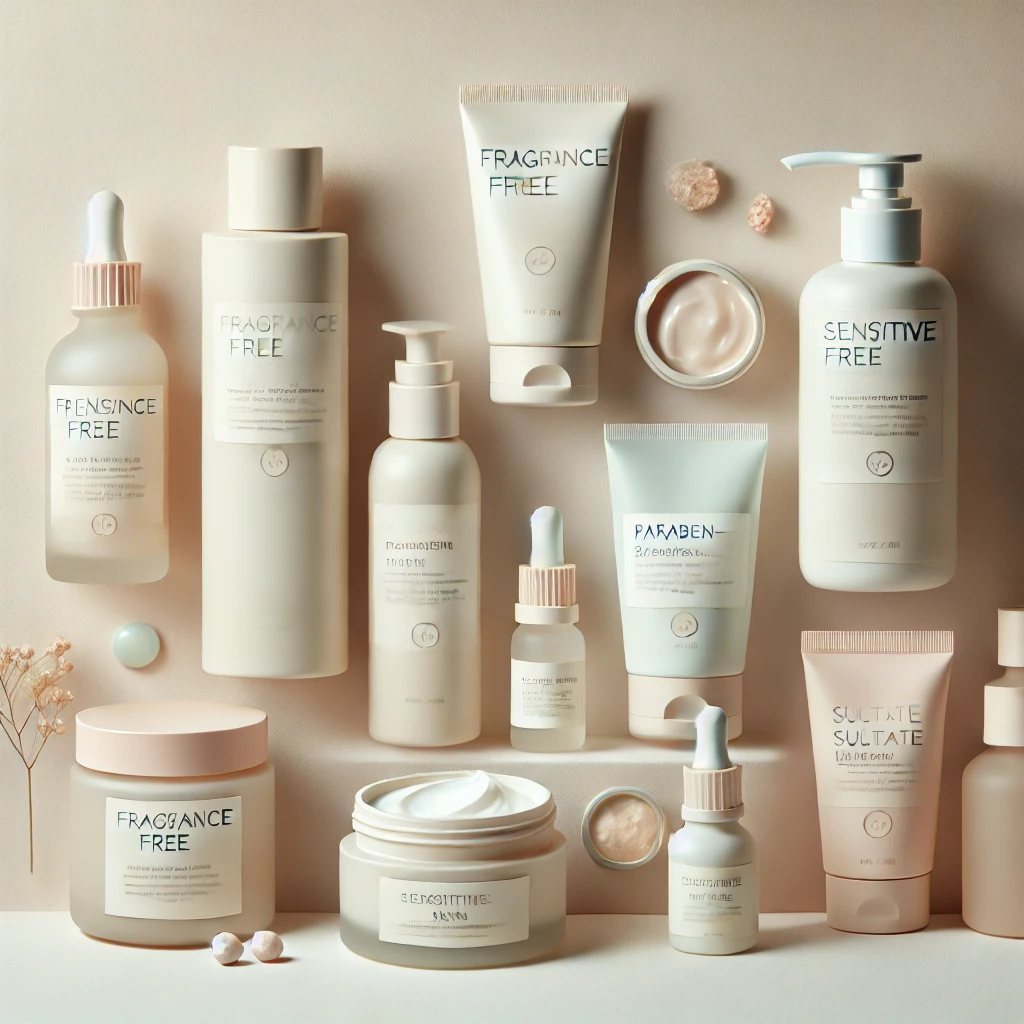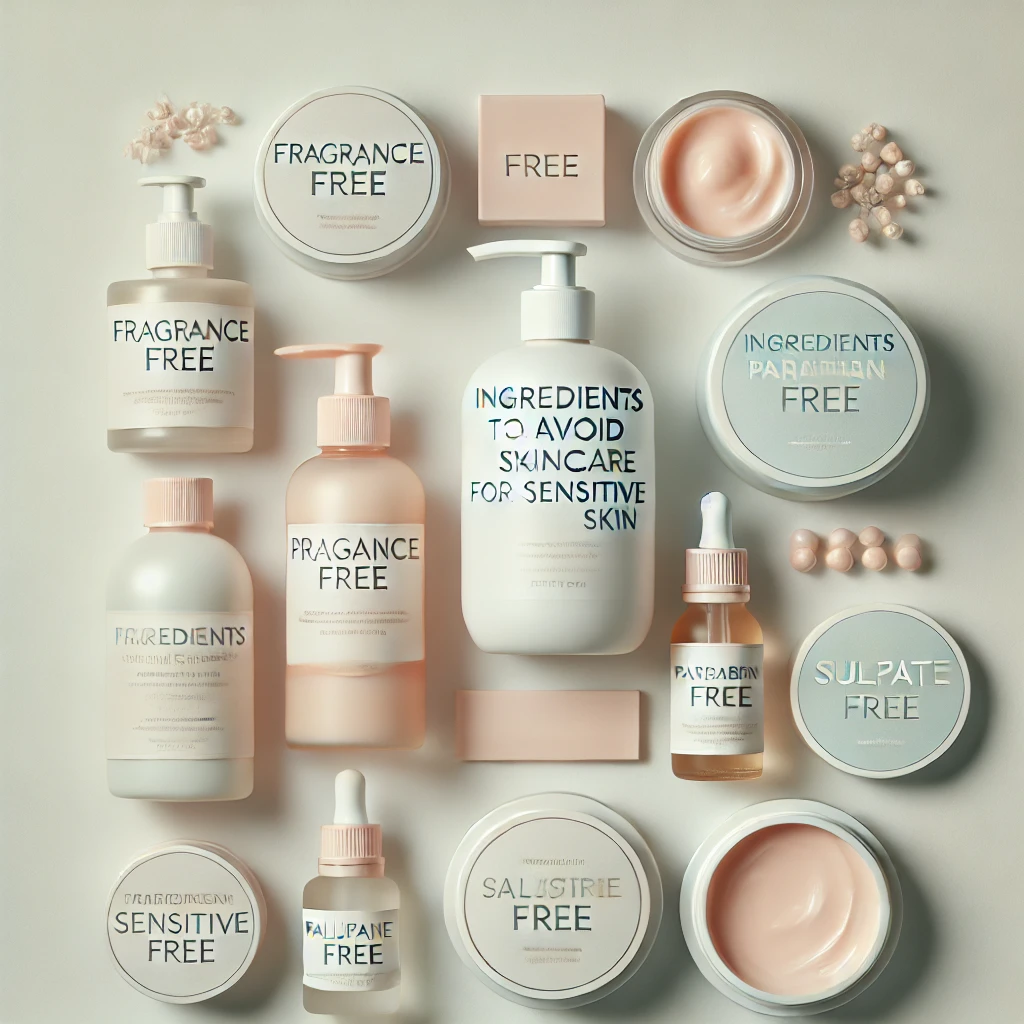
Protect your sensitive skin by avoiding these top irritant ingredients. Discover what to look for in skincare products and make better choices for healthier, irritation-free skin.
Sensitive skin requires special attention, especially when choosing skincare and beauty products. Certain ingredients in cosmetics and skincare can trigger irritation, redness, dryness, or even allergic reactions. This guide highlights the most common ingredients to avoid if you have sensitive skin, helping you make better choices and achieve a healthier, calmer complexion.
- 1. Fragrances and Perfumes
- 2. Alcohols (Ethanol, SD Alcohol, Isopropyl Alcohol)
- 3. Sulfates (Sodium Lauryl Sulfate & Sodium Laureth Sulfate)
- 4. Parabens
- 5. Synthetic Dyes and Colors
- 6. Essential Oils (Including Citrus, Peppermint, and Lavender)
- 7. Chemical Sunscreens (Oxybenzone, Octinoxate)
- 8. Exfoliating Acids (AHAs & BHAs)
- 9. Formaldehyde and Formaldehyde-Releasing Preservatives
- 10. Phthalates
- Conclusion
1. Fragrances and Perfumes
- Why to Avoid: Artificial fragrances, often labeled as “parfum,” are among the top causes of irritation and allergic reactions. Many fragrance compounds are synthetic, and their exact composition is often undisclosed.
- What to Look For: Seek products labeled “fragrance-free” or “unscented.” However, be cautious—”unscented” products may still contain masking fragrances.
2. Alcohols (Ethanol, SD Alcohol, Isopropyl Alcohol)
- Why to Avoid: While some alcohols (like fatty alcohols) are safe and beneficial, drying alcohols strip natural oils, leading to dehydration, redness, and inflammation.
- What to Look For: Avoid products with ingredients listed as ethanol, SD alcohol, or isopropyl alcohol. Look for “fatty alcohols” like cetyl, stearyl, or cetearyl alcohol, which are safe for sensitive skin.
3. Sulfates (Sodium Lauryl Sulfate & Sodium Laureth Sulfate)
- Why to Avoid: Common in cleansers and shampoos, sulfates strip the skin of natural oils and disrupt its natural barrier, leading to dryness, itchiness, and irritation.
- What to Look For: Choose sulfate-free products, which are often labeled as such. Look for mild, plant-based surfactants like cocamidopropyl betaine instead.
4. Parabens
- Why to Avoid: Used as preservatives, parabens can disrupt hormones and have been linked to skin irritation and allergic reactions in sensitive skin.
- What to Look For: Check for ingredients ending in “-paraben,” like methylparaben or butylparaben. Many brands now offer paraben-free products, so look for this label.
5. Synthetic Dyes and Colors
- Why to Avoid: Synthetic dyes can contain harmful chemicals that cause skin sensitivity, particularly in those prone to irritation. These are commonly found in makeup products.
- What to Look For: Opt for products without FD&C or D&C colors and choose natural colorants when possible.
6. Essential Oils (Including Citrus, Peppermint, and Lavender)
- Why to Avoid: Although natural, essential oils can be highly potent and may trigger irritation, photosensitivity, or allergic reactions in sensitive skin.
- What to Look For: Stick to products without essential oils, especially highly concentrated ones like lemon, orange, eucalyptus, and peppermint oils.

7. Chemical Sunscreens (Oxybenzone, Octinoxate)
- Why to Avoid: Chemical sunscreen ingredients can irritate sensitive skin, causing stinging or burning sensations. These compounds have also been linked to hormone disruption.
- What to Look For: Choose physical (mineral) sunscreens containing zinc oxide or titanium dioxide, which are gentler on sensitive skin.
8. Exfoliating Acids (AHAs & BHAs)
- Why to Avoid: While beneficial for many, alpha hydroxy acids (AHAs) and beta hydroxy acids (BHAs) can be too harsh for sensitive skin, leading to peeling, redness, and irritation.
- What to Look For: Look for gentle exfoliants like lactic acid at lower concentrations or enzyme-based exfoliators.
9. Formaldehyde and Formaldehyde-Releasing Preservatives
- Why to Avoid: Often used in nail products and hair treatments, formaldehyde is a known irritant and potential allergen. Sensitive skin can react negatively, with symptoms like itchiness or rashes.
- What to Look For: Avoid ingredients like quaternium-15, DMDM hydantoin, and diazolidinyl urea, which release formaldehyde over time.
10. Phthalates
- Why to Avoid: Found in fragrances, phthalates are known endocrine disruptors and can worsen skin sensitivities.
- What to Look For: Products labeled as “phthalate-free” are preferable for those with sensitive skin.
Conclusion
Choosing skincare and beauty products for sensitive skin can be challenging, but understanding which ingredients to avoid can make it easier to avoid irritation. Look for hypoallergenic, dermatologist-tested, fragrance-free, and non-comedogenic products to minimize the risk of reactions. By reading ingredient lists carefully, you can protect and nurture your sensitive skin for a calm, healthy, and radiant appearance.







